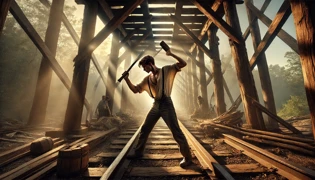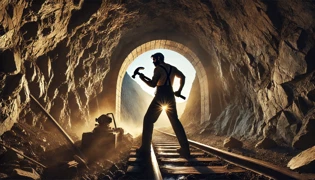Introduction
In the ragged shadows of the Appalachian Mountains, where dawn’s first light brushes the rocky peaks in hues of rose and gold, a man stands alone at the yawning mouth of a blasted tunnel. John Henry’s broad shoulders gleam with early sweat, and every sinew of his arms pulses with iron resolve. For years, he has walked among the crews that carve rail beds through the ancient stone, pickaxe and hammer in hand, chiseling tiny breaths of passage for the locomotive’s iron rails. Legend hints that from the moment he first lifted a hammer, he was destined to challenge not only the earth but the very machines mankind would build. Stories swirl around his name like dust—of hammers striking stone at the speed of lightning and of blasted mountains shrinking day by day beneath his relentless blows. Yet none of these tales capture the truth: a heart that surged with pride, fear for the gamble he planned, and a mind that knew the stakes could claim more than his muscles. This is the moment before history records his heroic contest. As the workers fell silent at the tunnel’s rim, a distant hiss announced an approaching challenger more powerful than any man-made rival before. Steam seethed from a monstrous iron contraption, its drill bit spinning like the wheel of a great furnace. And there, wrapped in the hush of expectation, John Henry lifted his hammer and prayed for nothing less than victory.
Forging a Legend
John Henry’s story began long before the steam hammer hissed into view. Born in a makeshift cabin carved from timber and slate, he arrived in the world as the thunder of rock met the ring of steel. His father had been a sharecropper, his mother a healer who gathered herbs from the forest floor. They toiled in soil and sweat, believing sweat was the price of survival. From the moment he could lift a hammer almost as tall as himself, John apprenticed to the railroad crews that hammered eastward through the mountains. It seemed that every swing of his war club picked up speed, as though it learned its own will. The work was cruel—chunks of carbon vein blasted free under steam and gunpowder, devils of dust choking each man to cough blood in the tunnels. Yet John sang through the labor, forging his legend every time iron met stone.

As the seasons turned, whispers rose among the camps of a boy who could chip ten times faster than a seasoned driver. When he set foot on fresh bedrock, the clamor of spades and picks hushed to watch. He swung his hammer with surgical precision, turning the pounding into a melody, until the men fell silent, awestruck by how a single man could shape the mountain’s fate. Workers from camps miles away traveled to see his arms arc through the dust, to feel the pulse of raw power that resonated through the stones like a distant heartbeat. By lantern and lantern, his name became myth, and myth a promise that no machine would ever wholly outmatch the human spirit.
Yet for all his spectacular feats, John Henry remained humble. He refused to rest in those mountain camps or showboat before the highest bidders. Instead, he wandered, helping crews lay track through nearly forgotten hollows and remote ridges. He repaired roofs on tiny stations, shared coffee with exhausted engineers, and offered kind words to laborers far from home. On frosty mornings, he salted his porridge with laughter. When storms rerouted rails into thick mud, he waded heel-deep, clearing logs and roots with a shovel until grading machines could pass. To John, no task was beneath him, and every crew became family. Each group he joined listened to his easy stories as he polished tools for the next day’s work, convinced they were in the presence of greatness yet also feeling they marched toward a larger purpose—one that would converge on a fateful challenge.
Rumors of a steam-drilling contraption reached the camps at last, a marvel that devoured rock with hissing jaws and spinning bits fueled by endless fire. Company bosses boasted they would soon employ the steam drill to complete the toughest passes in half the time, making steel drivers obsolete. Then someone dared John Henry to race the metal behemoth. It began as a joke among the higher-ups, a gauntlet meant to unmask the natural man’s limits. But when steely-eyed John accepted the wager, the forest around the camp seemed to hold its breath. Men laid bets, bosses poured whiskey, and engineers polished goggles as they prepared a grandstand cut into the hillside.
On the morning of the contest, dawn felt heavier. The earth trembled under the steam drill’s footings as it breathed fire and ash. Steam coils hissed like serpents, and the drumbeat of pistons echoed through the valley. At the tunnel’s yawning mouth, John Henry wiped sweat from his brow and flexed his fingers around the smooth oak handle of his hammer. His gaze, calm as twilight, met the drill’s roaring roar. Then, without a word, he brought the hammer down onto the quartz-veined rock with a hammerstrike that sounded like an anthem to defiance. Dust rose in a vast, earthen cloud, blotting out the sun. And as the world shook, John Henry’s arms moved so swiftly that steel met stone in a blur.
Conclusion
Long after the echo of the final hammer blow faded from the tunnel walls, John Henry’s legend took shape in song, story, and song again. Appalachian minstrels carried his feats over ridge and valley, while railroad gangs recited his name as a prayer for stamina through grueling days. His race against the steam drill became a parable, reminding every generation that when the machine roars louder, the human heart must pound harder. In towns carved from rail ties and timbers, children still learn to swing a hammer with hope, imagining that with each strike they honor a man whose courage reshaped the mountains. And though John Henry’s hammer once fell silent, his spirit endures, carved into the bedrock of a nation built by the promises of steel and the perseverance of flesh and blood. Today, when dawn’s light spreads over rusted tracks and abandoned tunnels, one can still sense the rhythm of those hammer strikes, calling forth determination, sacrifice, and a belief that our own greatest obstacles can yield to unyielding will. In every echo, the legend whispers: stand strong, strike true, and know that where machines push forward, the human spirit can still break the hardest stone forevermore.

















